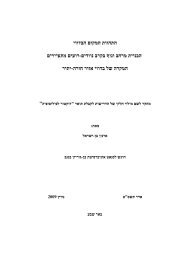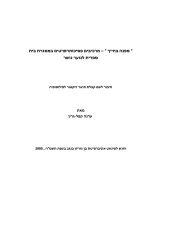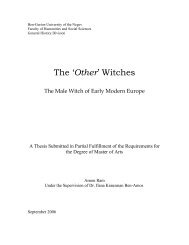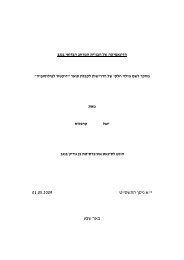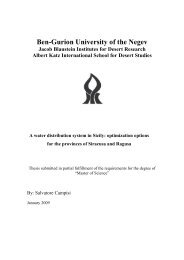רוח חן - אוניברסיטת בן-גוריון בנגב
רוח חן - אוניברסיטת בן-גוריון בנגב
רוח חן - אוניברסיטת בן-גוריון בנגב
You also want an ePaper? Increase the reach of your titles
YUMPU automatically turns print PDFs into web optimized ePapers that Google loves.
v<br />
communities through several channels. Some were brought from the Byzantine<br />
settlements, while others included copies, or copies of copies of printed editions<br />
of Rua˙ Óen, published in Italy and on Ashkenazi soil in the sixteenth century<br />
and in the beginning of the seventeenth century. Only a single Karaite printed<br />
edition of Rua˙ Óen was published: it appeared in the nineteenth century in the<br />
city of Gozlow (Eupatoria) in Crimea, and was intended for Karaite readers.<br />
For many of its readers, Rua˙ Óen served as a primary source, often as an<br />
exclusive source of knowledge in Aristotelian sciences. The text was passed<br />
down throughout the generations without any significant changes. As a result,<br />
readers of Rua˙ Óen remained unaware of scientific developments, not even<br />
those presented in Hebrew texts, let alone such that could be found in non-<br />
Hebrew texts only. Their world picture remained founded on basic medieval<br />
scientific theories, drawn from the scientific world of Muslim philosophers and<br />
uniquely presented in Rua˙ Óen; these were partly at variance with concepts<br />
presented in other scientific works (e.g. in Ibn Rushd's commentaries).<br />
In most of the investigated cultural settings, perhaps in all, there were<br />
teachers who introduced Rua˙ Óen as a science textbook into the syllabus. This<br />
type of utilization of Rua˙ Óen began already in Southern France and Italy, and<br />
continued in the Karaite communities and probably also among Ashkenazi<br />
readers. It stood out especially in the Italian Peninsula, and even more so<br />
among the Karaites. In the educational system of the latter, a tradition of<br />
reading Rua˙ Óen as part of science teaching was maintained. This tradition<br />
was rooted in the Byzanine Karaite center. Karaite scholars working in<br />
Byzantium in the fifteenth and sixteenth centuries taught Aristotelian sciences,<br />
mainly in preparation for studying texts on religious philosophy, Karaite as<br />
well as Rabbanite. Some of them chose to adopt Rua˙ Óen as a textbook. The<br />
Karaites in Eastern Europe and in Crimea continued to teach such texts that<br />
presupposed basic Aristotelian scientific knowledge. They used Rua˙ Óen as





